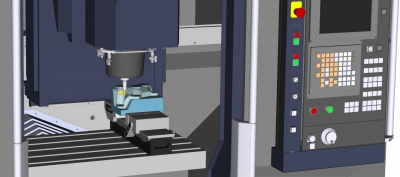
New computer-aided-manufacturing (CAM) technology has been introduced by ESPRIT CAM, part of Hexagon’s Manufacturing Intelligence division that provides manufacturers with the control and flexibility needed to use multi-spindle and multi-channel computer-numerical-control (CNC) machinery for the machining of long parts. More accurate simulation of spindle transfers and bar pulls enables manufacturers to exploit multi-tasking machinery with high productivity program creation of error-free toolpaths.
Machining long parts, such as shafts and axles, is challenging because they require that the workpiece is supported throughout to maintain cutting speed and surface quality. The main and sub spindles must be synchronised to ensure that cutting can be performed while both spindles hold the workpiece for maximum support. Bars are also frequently repositioned in incremental steps to keep workpieces rigid, as well as to account for limited bed length. Because the repeat repositioning of the bar presents a collision risk, it benefits machinists if they are supplied with NC code that tracks machine motion for greater flexibility and readability at the machine control.
Without the ability to track machine motion, a significant amount of time is spent hand-editing NC code and troubleshooting programs before production begins using complex multi-tasking scenarios. ESPRIT TNG CAM software now automatically tracks the location of work offsets regardless of part position by enabling programmers to define the offset and offset translations, or the points at which offset changes occur. In addition to enabling precise simulation, this eliminates the need for custom settings or calculations to the machine post to ensure that parts are machined accurately and makes it possible to program a greater number of complex machining scenarios without error.
“ESPRIT TNG is ‘the next generation’ CAM because it provides an exact digital replica of every facet of the machining environment to help manufacturers use the world’s most sophisticated, cutting-edge machine tools with confidence,” said Olivier Thenoz, ESPRIT principal product manager. “The ability to accurately track parts throughout complex operations means that users can make the most of the combined power of software and machinery for advanced multi-tasking, and that they have the freedom and flexibility needed to machine exactly the way they want to.”
ESPRIT TNG now also enables manufacturers to perform face-milling operations with a unique “roll-in” lead-in strategy recommended by Sandvik Coromant to improve surface quality, reduce cycle time, and extend tool life. This lead-in technique positions the cutter for ideal thick-to-thin chip formation, which indicates that the insert engages the material deeply enough at entry to make a significant cut before exiting smoothly to reduce vibration and ensure consistent, high-quality surface finish. In addition to being less damaging to cutter inserts, this strategy eliminates the need to manually calculate face-milling stepovers during the programming process, which automatically ensures a consistent and even surface across the entire workpiece.
The new release also offers productivity benefits for 3-axis operations. Toolpath creation is now 20 times faster, meaning that toolpath that once took 30 minutes to generate can now be calculated in about two minutes. Furthermore, a new 3-axis toolpath can now be created in ESPRIT TNG from an existing operation without recalculating the entire toolpath. Areas in collision can be trimmed from toolpath generated for use with short cutting tools, or re-machining operations can be created with a long tool to cut only areas that cannot be reached with the shorter tool.
ESPRIT TNG 4.7 is available from ESPRIT CAM now.
Contact Details
Related Glossary Terms
- computer-aided manufacturing ( CAM)
computer-aided manufacturing ( CAM)
Use of computers to control machining and manufacturing processes.
- cutting speed
cutting speed
Tangential velocity on the surface of the tool or workpiece at the cutting interface. The formula for cutting speed (sfm) is tool diameter 5 0.26 5 spindle speed (rpm). The formula for feed per tooth (fpt) is table feed (ipm)/number of flutes/spindle speed (rpm). The formula for spindle speed (rpm) is cutting speed (sfm) 5 3.82/tool diameter. The formula for table feed (ipm) is feed per tooth (ftp) 5 number of tool flutes 5 spindle speed (rpm).
- numerical control ( NC)
numerical control ( NC)
Any controlled equipment that allows an operator to program its movement by entering a series of coded numbers and symbols. See CNC, computer numerical control; DNC, direct numerical control.
- toolpath( cutter path)
toolpath( cutter path)
2-D or 3-D path generated by program code or a CAM system and followed by tool when machining a part.







